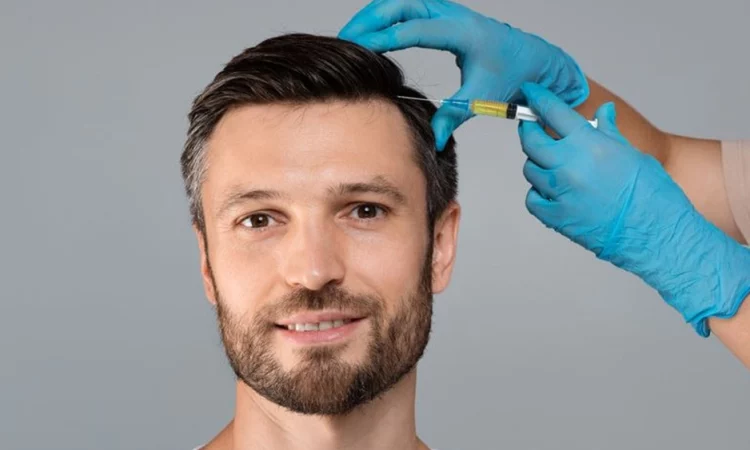Male pattern baldness, also known as androgenetic alopecia, is one of the most common causes of hair loss in men. Affecting nearly half of the male population by the age of 50, this condition is characterized by a gradual thinning of the hair, typically starting at the temples and crown. It often leads to a receding hairline and eventual baldness. As the condition progresses, many men seek solutions to restore their hair, asking the question: Can hair loss treatment in Dubai(علاج تساقط الشعرفي دبي) help with male pattern baldness?
Understanding Male Pattern Baldness:
Male pattern baldness is caused by a combination of genetics and hormones. The primary hormone responsible is dihydrotestosterone (DHT), a derivative of testosterone that shrinks hair follicles over time. When DHT attaches to the receptors in the hair follicles, it leads to their miniaturization. This causes the hair strands to become thinner, shorter, and weaker until they eventually stop growing altogether. Over time, this process results in the classic receding hairline and bald patches associated with male pattern baldness.
Genetics also play a significant role in determining when and how male pattern baldness will manifest. If your father or grandfather experienced early baldness, there's a higher likelihood that you may too. However, the onset, progression, and severity can vary widely among individuals, making it important to find a tailored approach to treatment.
The Different Types of Hair Loss Treatment:
Hair loss treatment options are available in a wide range, each targeting different causes of hair thinning. While many treatments offer promise, it's crucial to understand that not all solutions will work for every individual.
1. Medications: Medications are often the first line of defense in treating male pattern baldness. Two FDA-approved drugs are commonly prescribed to slow hair loss and stimulate regrowth. Finasteride (Propecia) is a prescription pill that works by blocking the conversion of testosterone into DHT. By reducing DHT levels, finasteride can help slow down the hair thinning process. On the other hand, minoxidil (Rogaine) is an over-the-counter topical solution applied directly to the scalp. Minoxidil helps increase blood flow to the hair follicles and promotes hair regrowth.
While both medications can be effective, they require continuous use to maintain results. Once you stop using them, the effects will gradually fade, and hair loss may resume.
2. Low-Level Laser Therapy (LLLT): Low-level laser therapy (LLLT) is a non-invasive treatment that uses red light to stimulate hair follicles. This technology is designed to increase circulation to the scalp and encourage hair regrowth. LLLT is commonly offered through devices like laser combs, helmets, and caps. While research on its effectiveness is still ongoing, some studies suggest that LLLT can improve hair density and thickness in individuals with male pattern baldness.
3. Platelet-Rich Plasma (PRP) Therapy: PRP therapy involves drawing a small amount of your blood, processing it to concentrate the platelets, and then injecting it back into the scalp. The platelets are rich in growth factors that can potentially stimulate hair follicles and promote the growth of new hair. PRP has gained popularity in recent years as a treatment for hair loss, but its long-term efficacy remains a topic of discussion.
4. Hair Transplants: For those with advanced male pattern baldness, hair transplant surgery may be the most effective treatment option. The procedure involves moving healthy hair follicles from areas of the scalp where hair is still growing to areas affected by baldness. There are two primary techniques for hair transplants: follicular unit extraction (FUE) and follicular unit transplantation (FUT). Both methods have their pros and cons, and the success of the procedure depends on the skill of the surgeon and the health of the donor hair.
5. Scalp Micropigmentation: Scalp micropigmentation is a non-surgical technique that involves tattooing tiny dots of pigment onto the scalp to mimic the appearance of a closely shaved head or thicker hair. This technique doesn’t restore hair growth but can create the illusion of fuller hair, especially for men with extensive hair loss.
Lifestyle Factors That Influence Hair Loss:
While treatments like medications and hair transplants focus on directly targeting the causes of hair loss, it's important to consider how your lifestyle can affect the health of your hair. Simple changes in daily habits can play a significant role in slowing down the process of male pattern baldness.
1. Nutrition: A balanced diet rich in vitamins and minerals is essential for healthy hair growth. Nutrients such as biotin, zinc, iron, and omega-3 fatty acids are particularly important for maintaining strong hair. Eating a variety of fruits, vegetables, lean proteins, and whole grains can support overall hair health and may help prevent excessive shedding.
2. Stress Management: Chronic stress is known to contribute to hair loss, particularly in the form of telogen effluvium, a condition where hair prematurely enters the shedding phase. Managing stress through relaxation techniques such as yoga, meditation, or regular exercise can help reduce its impact on your hair.
3. Hair Care Routine: The way you treat your hair on a daily basis can have an impact on its health. Avoid excessive heat styling, harsh chemicals, and tight hairstyles that can pull at the hair. Opt for gentle shampoos and conditioners that nourish the scalp and strengthen the hair follicles.
4. Sleep: Getting enough sleep is crucial for your overall health and well-being, including hair health. Sleep allows your body to repair and regenerate cells, including those in your scalp. Aim for 7-9 hours of quality sleep each night to support optimal hair growth.
The Effectiveness of Hair Loss Treatment:
When it comes to male pattern baldness, the effectiveness of hair loss treatment can vary depending on several factors, including the severity of the hair loss, the type of treatment, and individual responses. For some men, medications like finasteride and minoxidil may slow or stop hair loss, and in some cases, even promote new hair growth. However, the results are often subtle and take time to become visible.
Hair transplant surgery offers the most permanent solution for male pattern baldness, but it comes with its own set of challenges, including the cost, recovery time, and potential risks. Non-surgical options like LLLT and PRP therapy may offer more gradual results but tend to be less invasive and have lower upfront costs.
In any case, it's important to set realistic expectations when pursuing hair loss treatment. While it’s possible to slow down or reverse hair thinning, complete restoration to a full head of hair may not be achievable for everyone.
Maintaining Results and Long-Term Care:
Once you find a treatment that works for you, it's essential to maintain it to keep the results. Most treatments, particularly medications and laser therapy, require ongoing use to sustain their effects. Stopping treatment can lead to the resumption of hair loss, sometimes within a few months.
Additionally, practicing good scalp hygiene and adopting a healthy lifestyle can help extend the benefits of your treatment. Regular check-ins with a hair specialist can help you assess the progress and make adjustments if necessary.
Conclusion
Male pattern baldness is a common and often distressing condition, but hair loss treatment options are available to help manage and even reverse some of the effects. From medications and laser therapy to hair transplants, there are various avenues for addressing the condition. However, success is dependent on a variety of factors, and no treatment guarantees complete restoration. By understanding the causes of male pattern baldness and exploring the available treatments, men can make informed decisions about their hair loss journey and take proactive steps to preserve their hair.






Comments